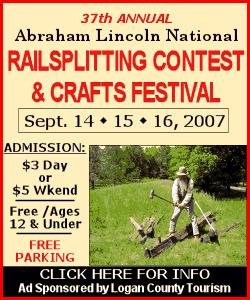|
"The return of the annunciator system, as it was called in the
1870s, is the culmination of a decade-long project involving many
skilled researchers, artisans and benefactors," said Marcia Young,
site manager at the David Davis Mansion. "Judge Davis, like his
friend and associate Abraham Lincoln, was fascinated by the latest
technology and made sure his large, new Bloomington home included
this novel communication system."
The mansion's original, mechanical communication system used
small levers, pull wires, bell cranks (sometimes called "dog legs")
and a mechanical annunciator panel to signal the maid to come to the
room where the caller was located. The original annunciator panel
was installed in the mansion's kitchen. Thus, when Sarah Davis or
another family member pulled a call bell lever in any room, the
pulling action, through a series of pulleys and dog legs, rang a
gong on the annunciator panel in the kitchen and tripped a metal
indicator, showing the maid where the caller was located.
One of the fascinating features of the system was a floor-mounted
device located underneath Sarah Davis' chair in the dining room,
which allowed her to summon the servants from the kitchen without
leaving her chair, to the surprise and delight of her guests. Guides
can demonstrate how the system worked from the dining room as well
as the sitting room and master bedroom by pulling the call bell
levers in those rooms.

The David Davis Mansion annunciator project began in 1996 with a
$4,000 grant from the Verizon Foundation. The Verizon funds were
matched by a $2,000 grant from the David Davis Mansion Foundation, a
private organization that supports the Davis Mansion's programs. The
late Judge Wayne Townley, a member of the Davis Mansion Foundation
board in the early 1990s, presented the grant proposal in 1995, and
Mary Jean Palma, a mansion volunteer and Verizon employee, helped
steer the proposal through the application process.
The original research on the mansion's annunciator system was
conducted in the 1980s by John Bowditch, then curator of technology
for the Henry Ford Museum. William Bond, a tool and die specialist
from Ann Arbor, Mich., who had replicated many of the mansion's
original mechanical systems during its 1990s restoration, was hired
to continue Bowditch's research, using museum archives throughout
the United States. What made the research so challenging was the
fact that the mansion's annunciator system was operated
mechanically, whereas most existing 19th-century call bell systems
were electrically operated. After a lengthy search, Bond was able to
locate vintage drawings and operating instructions that could be
used to reproduce the mansion's mechanical annunciator system. The
restoration team decided that it could only make the replica
function reliably, however, if they made it operate electrically.
[to top of second column] |
 Mansion staff began searching for artisans in the
Bloomington-Normal community who could turn the 19th-century
drawings into reality. With the help of Ken Menestrina, a member of
the David Davis Mansion Foundation board, a team of talented local
craftsmen was assembled that included George King, master carpenter;
Russ Roberts of Weber Electric, who fabricated the electrical
connections that made the panel functional; Tom Wheeler, Don Boyer
and Mike Folks of Conrad Sheet Metal Company, who made the metal
parts for the system; and Michael Henning, a decorative artist who
wood- grained the annunciator's casement.
One of the distinguishing features of the David Davis Mansion in
the 1870s was its mechanical systems -- gas lighting, central
heating, indoor plumbing and, especially, its communications
systems, including telephones, speaking tubes and call bells. Such
systems made the Davis Mansion one of the first modern homes in
central Illinois.
Today, these vintage mechanical systems are rare, as most were
discarded when they were replaced by more advanced technologies in
the 20th century. Although later generations of the Davis family
removed portions of the original systems whenever the mansion was
updated, they saved the majority of these systems, storing them in
outbuildings on the estate.
The
David Davis Mansion State Historic Site, administered by the
Illinois Historic Preservation Agency, is located just off of Route
9 in Bloomington. It is open Wednesday through Sunday for free
public tours.
[Text
from Illinois
Historic Preservation Agency news release received from the
Illinois Office of Communication and Information]
 |